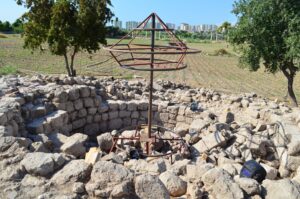Ongoing excavations in the ancient city of Soli Pompeipolis in the Mezitli district of southern Mersin province revealed the outlines of the memorial tomb of the famous Greek astronomer and poet Aratus.

Pompeiopolis (Greek: Πομπηιούπολις) was a Roman city in ancient Paphlagonia, identified in the early 19th century with the ruins of Zımbıllı Tepe, located near Taşköprü, Kastamonu Province in the Black Sea Region of Turkey. The exact location is 40 km north-east of Kastamonu and a short distance across the river from modern Taşköprü, in the valley of the Gökırmak (Greek Amnias). The borders of Pompeiopolis reached the Küre mountains to the north, Ilgaz mountains to the south, Halys river to the east and Pınarbaşı valley to the west.
Excavations on the tomb of Aratus are continuing under the direction of professor Remzi Yağcı, head of the Department of museology at Dokuz Eylül University.
Yağcı said in a statement to Anadolu Agency (AA) that the excavation work, which began on July 20 this year, had been ongoing for 75 days. Indicating that two rows of hexagonal structures and arches around the memorial tomb had been unearthed, he explained: “This place looks like a crater and has a circular plot worthy of an astronomer. We have also come across a solid and large monumental structure. ”

Emphasizing that the memorial tomb of Aratus was of great archaeological and touristic importance, Yağcı said: “For the first time, a memorial tomb has been unearthed linked to the archaeology of the ancient city of Soli Pompeiopolis. Aside from more familiar structures, such as the colonnaded streets, the ancient port, the theater, and the bathhouse, something very unique has been found. This find brings dynamism to the ancient city and can influence tourism in the region – for both those interested in cultural heritage and general visitors to the region."
The professor added that Aratus was greatly famed across the Hellenistic and Roman periods and his works are still studied to this day.
NASA has even named a crater on the moon after Aratus. "Therefore," said Yağcı: "I think that the tomb of Aratus will be included in the UNESCO World Cultural Heritage List.”


